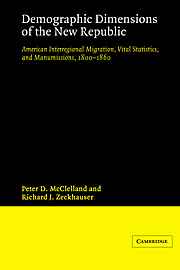 Demographic Dimensions of the New Republic
Demographic Dimensions of the New Republic Published online by Cambridge University Press: 19 September 2009
General
Estimates of net migration, by decade, are presented in Tables C-1 and D-1. The numbers include only those migrants who survived to the next census enumeration. Data are broken down by both region and age cohort for males, females, and the two sexes combined. The row labeled ‘Total immigration’ represents estimated net international migration into the United States for a given age cohort during the decade in question.
White population 1800–60
If one focuses on migration data for both sexes, a number of patterns are apparent for the different regions of Map 1, some of them unsurprising, and some quite unexpected.
(a) New England. Throughout the period this region tended to be a net loser of population, but several developments are curious. The largest absolute loss occurred in the decade 1810–20, well before the completion of the Erie Canal. If population movements are symptomatic of relative economic strength, the decade 1810–20 was the worst for the region's economy. By the same reasoning, the 1840s apparently were the best, at least in the 1800–60 period. The pattern of in-migration in the youngest cohort during the 1840s suggests the possibility of data imperfections in that cohort, but the above inference is also supported by the sharp reduction in the exodus of all other cohorts in the 1840s. Admittedly, the linkage of population change to conclusions about economic welfare should perhaps be tempered in this case by considerations relating to the influx of impoverished Irish men and women, but the era in which New England railroad building boomed was clearly atypical in terms of population flows.
[…]
To save this book to your Kindle, first ensure [email protected] is added to your Approved Personal Document E-mail List under your Personal Document Settings on the Manage Your Content and Devices page of your Amazon account. Then enter the ‘name’ part of your Kindle email address below. Find out more about saving to your Kindle.
Note you can select to save to either the @free.kindle.com or @kindle.com variations. ‘@free.kindle.com’ emails are free but can only be saved to your device when it is connected to wi-fi. ‘@kindle.com’ emails can be delivered even when you are not connected to wi-fi, but note that service fees apply.
Find out more about the Kindle Personal Document Service.
To save content items to your account, please confirm that you agree to abide by our usage policies. If this is the first time you use this feature, you will be asked to authorise Cambridge Core to connect with your account. Find out more about saving content to Dropbox.
To save content items to your account, please confirm that you agree to abide by our usage policies. If this is the first time you use this feature, you will be asked to authorise Cambridge Core to connect with your account. Find out more about saving content to Google Drive.